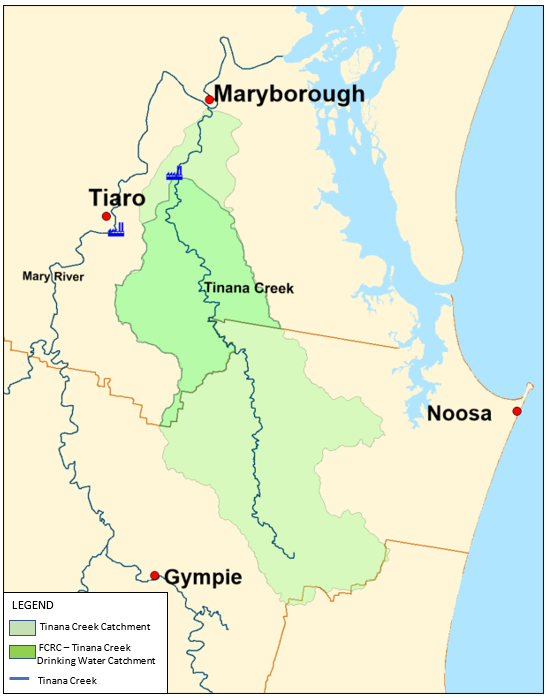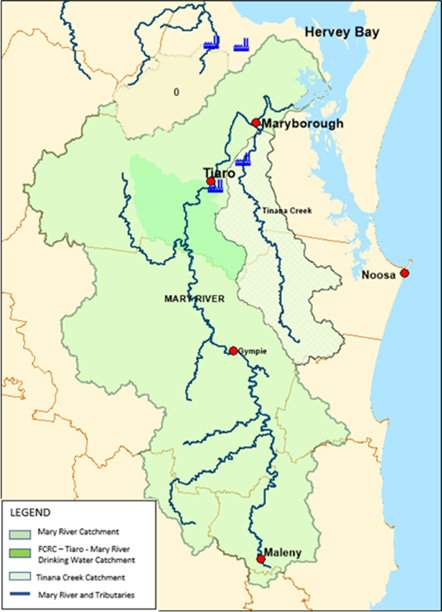
Fraser Coast Drinking Water Catchment Management Strategy
FAQS
Drinking water catchments are areas where rainwater is collected by the natural landscape and eventually flows via creeks, rivers and underground systems into drinking water storages, such as dams, weirs and barrages.
The Fraser Coast’s drinking water catchment areas are located along the Burrum River, Mary River and Tinana Creek.
A healthy drinking water catchment has large areas of vegetation with productive soils providing lots of opportunities for rainwater to flow overland into creeks and rivers, and to seep into the ground. Healthy vegetation and soils utilise the rainwater as it flows overland and seeps through the ground.
The water eventually flows into drinking water storages such as the Fraser Coast’s dams, weirs and barrages.
Healthy drinking water catchments ensure quality water is available to the environment and the community. Heathy catchments don’t increase the quantity of water available, but they do improve the quality of water available.
For information about securing adequate water supplies to meet growing demand on the Fraser Coast, you’re welcome to read about Council’s Water Security Study here.
Council undertakes drinking water catchment management activities such as
- community education
- fire and hazard reduction management
- management and monitoring of aquatic and environmental weeds
- regular sampling, testing and monitoring of water quality
- vegetation and biodiversity conservation.
Council’s Wide Bay Water and Waste Services Department undertakes drinking water catchment management activities that include:
- regular sampling, testing and monitoring of water quality
- management and monitoring of aquatic and environmental weeds
- fire management and hazard reduction
- vegetation and biodiversity conservation
- community education.
Healthy catchments ensure quality water is available to the environment and the community. Heathy catchments don’t increase the amount of water available, but they do improve the quality of water available. For information about securing adequate water supplies to meet growing demand on the Fraser Coast, you’re welcome to read about Council’s Water Security Study here.
Hervey Bay's (postcodes 4655, 4662, 4659) drinking water is sourced from Lake Lenthall located on the Burrum River.
- Water is channelled from the Lake Lenthall dam through two Burrum River weirs
- then pumped to the Howard and Burgowan Water Treatment Plants, and
- the treated drinking water is stored and supplied to Fraser Coast customers.
Visitors need to be aware that access to Lake Lenthall is via a rough dirt road. The road is controlled and maintained by Forest Products, a business unit of the Queensland Government. Accessing Lake Lenthall is at your own risk and a 4WD is recommended. The Lake Lenthall Ranger will not be able to assist with towing vehicles if they become stuck.

Hervey Bay's drinking water catchment.
Maryborough's (postcode 4650) drinking water is sourced from the Teddington Weir located on Tinana Creek. Tinana Creek is a major tributary of the Mary River.
- Water from the Teddington Weir is pumped to the Teddington Water Treatment Plant
- then the treated drinking water is stored and supplied to Fraser Coast customers

Maryborough's drinking water catchment
Tiaro’s (postcode 4650) drinking water is sourced from the Mary River upstream from the Mary Barrage.
- Water from the Mary River is pumped to the Tiaro Water Treatment Plant
- then the treated drinking water is stored and supplied to Fraser Coast customers.

Tiaro’s drinking water catchment
To keep the Fraser Coast’s drinking water catchments healthy Council’s drafted these Principles.
- Council will prioritise drinking water catchment management actions through long-term planning and investment.
- Council will protect our drinking water catchments through Council run and key stakeholder led programs and projects.
- Council will understand and apply this understanding in our drinking water catchments through targeted sampling, monitoring, surveillance, and research actions.
- Council will educate and collaborate with the community and key stakeholders about drinking water catchment knowledge, resources and projects.
- Council will value our drinking water catchments beyond the provision of safe and reliable drinking water focusing on environmental, cultural, social, and economic values.




